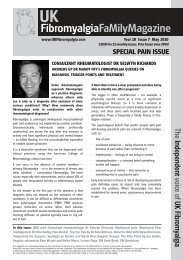DECEMBER 2009 FAMILY - UK Fibromyalgia
DECEMBER 2009 FAMILY - UK Fibromyalgia
DECEMBER 2009 FAMILY - UK Fibromyalgia
Create successful ePaper yourself
Turn your PDF publications into a flip-book with our unique Google optimized e-Paper software.
Guaifenesin – does it work<br />
By Christine Craggs-Hinton<br />
Page three - Guaifenesin – does it work<br />
In recent years, a medicine called ‘guaifenesin’,<br />
derived from the guaiac tree, has been<br />
propounded by some as a possible cure for<br />
fibromyalgia. However, there are plenty of<br />
others who assert that it is no more effective<br />
than a placebo (simple sugar pill). So what is the<br />
truth of the matter<br />
Guaifenesin was introduced as a medicine in the 20th<br />
century and is a component of many over-the-counter<br />
cough and cold remedies, its function being to loosen<br />
phlegm and mucus in the lungs. It was endocrinologist Dr<br />
R. Paul St. Armand who first advocated its use in<br />
fibromyalgia after determining that the muscles in this<br />
condition become clogged by calcium phosphate build-up<br />
(this is a type of salt). He believes that guaifenesin prompts<br />
the kidneys to eliminate this and other unwanted stored<br />
matter from the body via the urine and sweat, which is<br />
liable to become dark and pungent-smelling, as a result.<br />
For years, the odour and colour-change was taken as a<br />
clear sign that something positive was happening and so<br />
seemed to confirm the efficacy of guaifenesin, as did the<br />
muscle aches, headaches, anal irritation, overwhelming<br />
fatigue and mild depression which arises during the<br />
therapy – difficult to cope with when you are already<br />
struggling with fibromyalgia. In fact, the therapy came with<br />
the warning, ‘Not for wimps’.<br />
In Dr St. Armand’s 2006 book, What Your Doctor May Not<br />
Tell You About <strong>Fibromyalgia</strong>: The Revolutionary Treatment<br />
That Can Reverse the Disease’, he asserts that guaifenesin<br />
therapy prompts a reversal of the fibromyalgia process,<br />
with increasingly longer cycles of symptom-free periods.<br />
He adds a strong warning that products containing<br />
salicylates should be avoided as they can interfere with<br />
guaifenesin function. Salicylates is a plant hormone, used<br />
in topical creams to ease aches and pains and reduce<br />
fever. It is also a key ingredient in makeup and many<br />
topical products for the treatment of acne, psoriasis,<br />
calluses, corns and warts. It is used in shampoos to treat<br />
dandruff, too.<br />
Interestingly, though, a one-year placebo-controlled<br />
double-blind study which was never published indicated<br />
that guaifenesin was no more effective than a placebo.<br />
Blood tests also showed that it could not possibly work as<br />
Dr St. Armand believes (as shown below). When the chief<br />
author of the study, Robert Bennett M.D., was interviewed<br />
by the U.S. <strong>Fibromyalgia</strong> Network, he stated that<br />
guaifenesin had been popular for so long because there<br />
are many internet sites promoting it as a ‘cure’ for the<br />
condition – and what fibromyalgia sufferer can’t resist<br />
that<br />
However, advocates for the use of guaifenesin claim that<br />
Dr Bennett’s study was fatally flawed because patients<br />
may involuntarily have used salicylates, which would<br />
render the therapy ineffective. In the interview mentioned<br />
above, Dr Bennett, gave several scientifically-based<br />
reasons that guaifenesin therapy is ‘grossly over-rated’:<br />
In the study, both the serum and urinary levels of uric acid<br />
and calcium phosphate were all in the normal range and<br />
no increase in excretions was noted over time. Thus the<br />
postulated action of guaifenesin was not demonstrated.<br />
If some patients were using salicylates by some means,<br />
there would have been a significantly reduced urinary<br />
excretion and elevated serum level of uric acid. This was<br />
not observed.<br />
Dermatology consultants to Dr. Bennett have explained<br />
that patients would have to plaster their face with makeup<br />
several times a day to absorb enough salicylates to affect<br />
their urinary excretion of uric acid.<br />
In the early days of fibromyalgia, symptoms come and go<br />
on a cyclical basis, becoming more frequent and<br />
heightening in intensity as time goes by. Guaifenesin<br />
therapy is said to take the person back through those early<br />
days except that the symptoms now show themselves in<br />
reverse order through increasingly shorter and less severe<br />
cycles. This claimed ‘cycling of symptoms’ was not<br />
observed in the study.<br />
I have attempted here to present the facts of a contentious<br />
issue – so whether or not you try guaifenesin is entirely<br />
your choice. Plenty people with fibromyalgia are still opting<br />
to use it in the belief anything is worth a try. If it doesn’t<br />
work, they say, there’s no harm done.





